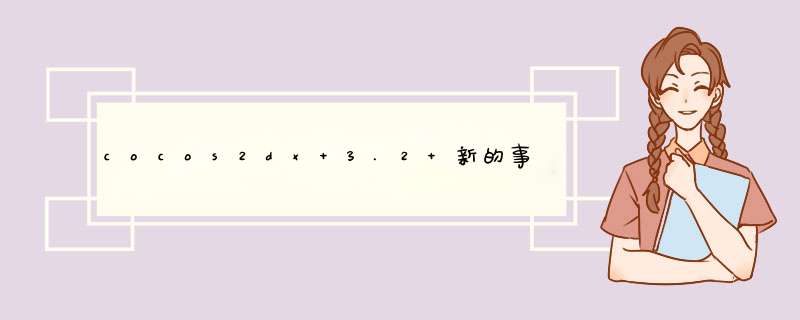
cocox2dx 3.2的事件系统是基于观察者模式,又称订阅者模式来实现的。
观察者/订阅者模式 概述 观察者模式定义了一种一对多的依赖关系,多个观察者(订阅者)对象同时监听某一状态对象。这个对象的状态改变后,会通知所有(或者选择性的)观察者对象。 实现方式 参与实现该模式的模型包括触发者、响应者、事件分发器。程序运行中,触发者向事件分发器发送一种类型的状态改变消息,事件分发器获取到状态消息时,检查是否有响应者已经订阅过此消息,如果有,则转发给相应的响应者去处理该消息。如果没有,则不做任何处理。 优缺点 优点: 1,减少了模块之间的耦合度。 2,程序运行中动态的决定是否响应某个事件。 3,代码层次更为清晰,模块独立性更好,有利于单元测试。 缺点: 事件分发器发送状态消息时,会涉及到响应者的排序,查询等 *** 作,当需要更新的状态比较多时,影响程序的性能,尤其是游戏中有每帧都有很多UI状态要改变时,比较影响实时性能。 cocos2dx 3.2的事件机制 cocos2dx 3.2中把触摸、键盘、鼠标、加速度、重力感应、焦点改变、以及用户自定义的消息事件类全部继承自了EventListener类,使用起来更为方便。/** * The base class of event Listener. * If you need custom Listener which with different callback,you need to inherit this class. * For instance,you Could refer to EventListeneracceleration,EventListenerKeyboard,EventListenertouchOneByOne,EventListenerCustom. */class EventListener : public Ref{public: enum class Type { UNKNowN,touch_ONE_BY_ONE,touch_ALL_AT_ONCE,KEYBOARD,MOUSE,acceleration,FOCUS,#if (CC_TARGET_PLATFORM == CC_PLATFORM_ANDROID || CC_TARGET_PLATFORM == CC_PLATFORM_IOS) GAME_CONTRolLER,#endif CUSTOM }; typedef std::string ListenerID;protected: /** Constructor */ EventListener(); /** Initializes event with type and callback function */ bool init(Type t,const ListenerID& ListenerID,const std::function<voID(Event*)>& callback);EventListener类中有三个开发者需要了解的类型: Type,即事件类型,是触摸消息还是键盘消息,或者是开发者自定义的消息。只有七种类型,分别是单点触摸,多点触摸,键盘事件,鼠标事件,重力加速度消息,焦点改变消息,以及开发者自定义消息。这里使用的CUSTOM消息,其实是跟2.x版本中的NotificationCenter使用效果是一样的。 ListenerID,是为了区分具体的响应者。除了CUSTOM类型以外,其他类型ListenerID和type都是唯一一个。CUSTOM类型,ListenerID是创建时开发者自己定义的,EventListener接收到带有ListnerID的CUSTOM类型消息时,会根据ListnerID查找相应的响应者处理,对应下面接口中的eventname。 EventListenerCustom* Eventdispatcher::addCustomEventListener(const std::string &eventname,const std::function<voID(EventCustom*)>& callback){ EventListenerCustom *Listener = EventListenerCustom::create(eventname,callback); addEventListenerWithFixedPriority(Listener,1); return Listener;} callback,响应者的消息处理函数。 触摸事件的使用方式 3.x版本中的触摸分为两种类型,多点触摸:EventListenertouchAllAtOnce,单点触摸:EventListenertouchOneByOne。 EventListenertouchAllAtOnce const std::string EventListenertouchAllAtOnce::ListENER_ID = "__cc_touch_all_at_once";
class EventListenertouchAllAtOnce : public EventListener{public: static const std::string ListENER_ID; static EventListenertouchAllAtOnce* create(); virtual ~EventListenertouchAllAtOnce(); /// OverrIDes virtual EventListenertouchAllAtOnce* clone() overrIDe; virtual bool checkAvailable() overrIDe; //public: std::function<voID(const std::vector<touch*>&,Event*)> ontouchesBegan; std::function<voID(const std::vector<touch*>&,Event*)> ontouchesMoved; std::function<voID(const std::vector<touch*>&,Event*)> ontouchesEnded; std::function<voID(const std::vector<touch*>&,Event*)> ontouchesCancelled; 多点触摸继承自EventListener,TYPE为touch_ALL_AT_ONCE,Listener_ID为,__cc_touch_all_at_once,从ontouchesBegan方法中可以看出,这里是一次处理了多个触摸点的消息。 EventListenertouchOneByOne
const std::string EventListenertouchOneByOne::ListENER_ID = "__cc_touch_one_by_one";
class EventListenertouchOneByOne : public EventListener{public: static const std::string ListENER_ID; static EventListenertouchOneByOne* create(); virtual ~EventListenertouchOneByOne(); voID setSwallowtouches(bool needSwallow); bool isSwallowtouches(); /// OverrIDes virtual EventListenertouchOneByOne* clone() overrIDe; virtual bool checkAvailable() overrIDe; //public: std::function<bool(touch*,Event*)> ontouchBegan; std::function<voID(touch*,Event*)> ontouchmoved; std::function<voID(touch*,Event*)> ontouchended; std::function<voID(touch*,Event*)> ontouchCancelled;单点触摸的实现方式也是继承自EventListener,TYPE为touch_ONE_BY_ONE,Listener_ID为__cc_touch_one_by_one,这里是将多个触摸消息按照触发顺序依次响应,例如如果同时在屏幕上按了四个点,则触摸响应函数会触发四次。ontouchBegan是需要注意的一个函数,返回值是bool,程序至少得实现这个函数,否则无法接收到触摸消息。返回值为false的时候,ontouchmoved,ontouchended,ontouchCancelled则不再执行,触摸消息直接传递给下一个接收者。2.x版本的触摸当这个函数返回true时表示吞噬触摸消息,不再往下传递。3.x版本需要设置setSwallowtouched为true,则触摸消息不再往下传递。在此事件中需要 处理两个按钮不能同时响应的问题。 触摸的另一个问题是如何控制触摸响应的顺序,触摸响应的顺序根响应的优先级有关。如下是创建触摸的两个通用函数: /** Adds a event Listener for a specifIEd event with the priority of scene graph. * @param Listener The Listener of a specifIEd event. * @param node The priority of the Listener is based on the draw order of this node. * @note The priority of scene graph will be fixed value 0. So the order of Listener item * in the vector will be ' <0,scene graph (0 priority),>0'. */ voID addEventListenerWithSceneGraPHPriority(EventListener* Listener,Node* node); /** Adds a event Listener for a specifIEd event with the fixed priority. * @param Listener The Listener of a specifIEd event. * @param fixedPriority The fixed priority of the Listener. * @note A lower priority will be called before the ones that have a higher value. * 0 priority is forbIDden for fixed priority since it's used for scene graph based priority. */ voID addEventListenerWithFixedPriority(EventListener* Listener,int fixedPriority);第一个接口,是根据node元素的绘制顺序来决定触摸优先级,元素越晚绘制,即元素的zorder越高,则优先级越高。即使动态改变了node元素的层级关系,触摸也能正常响应。接口注释中也写得比较清楚,接口会默认把元素的优先级设置为0。触摸分发时,先分发优先级小于0的,然后再分发等于0的,即是根据元素层级关系来分发,最后分发大于0的。元素移除时,会自动移除相关联的触摸监听者。 第二个接口,是直接设置了触摸响应的优先级,可以设置除了0之外的优先级。优先级越低,触摸响应越早。即按照优先级从小到大的顺序分发。 触摸使用示例:
auto touchListener = EventListenertouchOneByOne::create(); touchListener->ontouchBegan = CC_CALLBACK_2(RoomLayer::ontouchBegan,this); touchListener->ontouchended = CC_CALLBACK_2(RoomLayer::ontouchend,this); touchListener->ontouchCancelled = CC_CALLBACK_2(RoomLayer::ontouchCancle,this); touchListener->setSwallowtouches(true); _eventdispatcher->addEventListenerWithSceneGraPHPriority(touchListener,btn);
开发者自定义事件使用示例: 这是监听游戏从后台进入前台时的消息,其他的事件消息类似使用方式。
auto toForegroundListener = EventListenerCustom::create(EVENT_COME_TO_FOREGROUND,[this](EventCustom* event) { ontouchended(nullptr,nullptr); }); _eventdispatcher->addEventListenerWithSceneGraPHPriority(toForegroundListener,this); 总结 以上是内存溢出为你收集整理的cocos2dx 3.2 新的事件分发机制 (观察者/订阅者模式)全部内容,希望文章能够帮你解决cocos2dx 3.2 新的事件分发机制 (观察者/订阅者模式)所遇到的程序开发问题。
如果觉得内存溢出网站内容还不错,欢迎将内存溢出网站推荐给程序员好友。
欢迎分享,转载请注明来源:内存溢出

 微信扫一扫
微信扫一扫
 支付宝扫一扫
支付宝扫一扫
评论列表(0条)